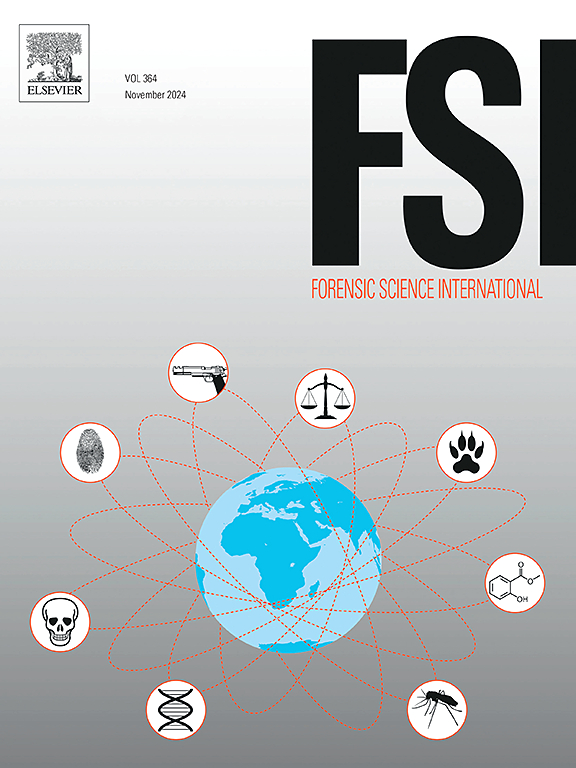Interlaboratory study to evaluate background databases for the calculation of likelihood ratios in the interpretation of vehicle glass evidence using LA-ICP-MS data
IF 2.5
3区 医学
Q1 MEDICINE, LEGAL
引用次数: 0
Abstract
Glass samples were analyzed by 13 laboratories participating in an interlaboratory study that used laser ablation inductively coupled plasma mass spectrometry (LA-ICP-MS) with a standard test method (ASTM E2927–23) for the forensic analysis and comparison of vehicle glass. The aim of this study was to explore the performance of the application of a match criterion described in the standard test method and from likelihood ratio (LR) calculations when reporting the significance of glass evidence comparisons. Five (5) databases populated in different countries and combinations of the databases were used as background data to calculate LRs for two (2) casework scenarios involving vehicle glass comparisons. When the ASTM E2927–23 was used to compare vehicle glass samples that originated from the same source, all laboratories (except one) correctly reported the samples to be indistinguishable thus concluding that the possibility that the glass originated from the same source could not be eliminated. When the LR was calculated for the same comparison, most laboratories obtained large LR values (≈ 10,000) interpreted as “strong support” for same-source proposition. The LR rate of misleading evidence for the same-source (ROME-ss) comparisons was < 2 % for scenario 1. Comparing vehicle glass samples known to originate from different sources resulted in most laboratories reporting the glass to be “distinguishable” when using the ASTM standard method criterion or produced very small LR values (≈ 0.0001) when using the LR comparison criteria, interpreted as “strong (or very strong) support” for different-source proposition. The LR rate of misleading evidence for different-source (ROME-ds) comparisons for scenario 1 was < 21 %, which was due to the number of comparisons of glass samples that are chemically similar (different vehicles but same source of manufacturing). If the chemically similar glass comparisons from the same manufacturer were not treated as “different source”, the ROME-ds was reduced to zero. Glass samples that were chemically similar (those that originated from different vehicles but were collected from the same make, model, and year or originated from the same vehicle but a different pane of glass) sometimes resulted in an LR value (≈ 1) interpreted as no support of either proposition or that the possibility that the glass originated from the same source could not be eliminated when using the ASTM match criterion. The laboratories reported approximately 20 % false support for same-source proposition (or “false inclusion”) and 7 % false support for different-source proposition (or “false exclusion”) when using the ASTM match criterion in the first scenario. All “false inclusions” were derived from the comparison of chemically similar samples, such as inner and outer panes from the same windshield, thus “error rates” on this dataset should not be generalized outside of the context of this study. A database composed of about 2000 background samples originating from different countries and analyzed in different laboratories, produced consistent results. When examined for calibration, all databases and their combinations had “false exclusion” rates below 5 % as well as “false inclusion” rates below 0.5 % for the ASTM calculation. The rate of misleading evidence of LR for same-source comparisons for the databases and their combinations was below 2 % and the rate of misleading evidence for different-source comparisons was below 2 %. An empirical cross entropy (ECE) plot was used to evaluate the calibration of all the databases and their combinations, which resulted in the log-likelihood ratio cost (Cllr) of less than 0.02.
利用LA-ICP-MS数据对汽车玻璃证据解释中计算似然比的背景数据库进行实验室间研究
参与一项实验室间研究的13个实验室对玻璃样品进行了分析,该研究使用激光烧蚀电感耦合等离子体质谱(LA-ICP-MS)和标准测试方法(ASTM E2927-23)对汽车玻璃进行法医分析和比较。本研究的目的是探讨在报告玻璃证据比较的显著性时,应用标准检验方法和似然比(LR)计算中描述的匹配标准的性能。使用分布在不同国家的五(5)个数据库及其组合作为背景数据,计算涉及车辆玻璃比较的两(2)个案例情景的LRs。当使用ASTM E2927-23来比较来自同一来源的汽车玻璃样品时,所有实验室(除了一个)都正确地报告了样品无法区分,从而得出结论,玻璃来自同一来源的可能性无法消除。当计算相同比较的LR时,大多数实验室获得较大的LR值(≈10,000),这被解释为对同一来源命题的“有力支持”。相同来源(ROME-ss)比较中误导性证据的LR率在情景1中为<; 2 %。比较已知来自不同来源的汽车玻璃样品导致大多数实验室在使用ASTM标准方法标准时报告玻璃是“可区分的”,或者在使用LR比较标准时产生非常小的LR值(≈0.0001),这被解释为对不同来源主张的“强烈(或非常强烈)支持”。在情景1中,不同来源(roome -ds)比较的误导性证据的LR率为<; 21 %,这是由于化学性质相似的玻璃样品的比较次数(不同的车辆但相同的制造来源)。如果来自同一制造商的化学成分相似的玻璃不被视为“不同来源”,则ROME-ds将减少到零。化学性质相似的玻璃样品(来自不同车辆但从同一品牌、型号和年份收集的玻璃样品,或来自同一车辆但不同玻璃面板的玻璃样品)有时会导致LR值(≈1)被解释为不支持任何一种主张,或者在使用ASTM匹配标准时不能消除玻璃来自同一来源的可能性。当在第一种情况下使用ASTM匹配标准时,实验室报告了大约20% %对同一来源命题的错误支持(或“错误包含”)和7% %对不同来源命题的错误支持(或“错误排除”)。所有的“假夹杂物”都来自于化学相似样品的比较,例如来自同一挡风玻璃的内外玻璃,因此该数据集的“错误率”不应该在本研究的背景之外推广。一个由来自不同国家并在不同实验室进行分析的大约2000个背景样本组成的数据库得出了一致的结果。当进行校准检查时,所有数据库及其组合在ASTM计算中的“假排除”率低于5 %,“假纳入”率低于0.5 %。对于数据库及其组合的同一来源比较,LR的误导性证据率低于2 %,而对于不同来源比较,LR的误导性证据率低于2 %。采用经验交叉熵(ECE)图对所有数据库及其组合的校准进行评估,结果表明对数似然比成本(Cllr)小于0.02。
本文章由计算机程序翻译,如有差异,请以英文原文为准。
求助全文
约1分钟内获得全文
求助全文
来源期刊

Forensic science international
医学-医学:法
CiteScore
5.00
自引率
9.10%
发文量
285
审稿时长
49 days
期刊介绍:
Forensic Science International is the flagship journal in the prestigious Forensic Science International family, publishing the most innovative, cutting-edge, and influential contributions across the forensic sciences. Fields include: forensic pathology and histochemistry, chemistry, biochemistry and toxicology, biology, serology, odontology, psychiatry, anthropology, digital forensics, the physical sciences, firearms, and document examination, as well as investigations of value to public health in its broadest sense, and the important marginal area where science and medicine interact with the law.
The journal publishes:
Case Reports
Commentaries
Letters to the Editor
Original Research Papers (Regular Papers)
Rapid Communications
Review Articles
Technical Notes.
 求助内容:
求助内容: 应助结果提醒方式:
应助结果提醒方式:


